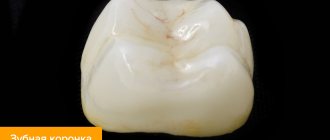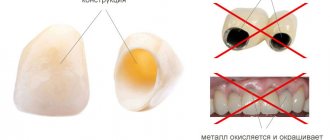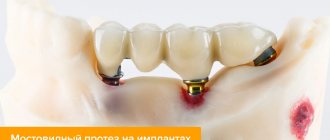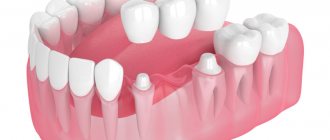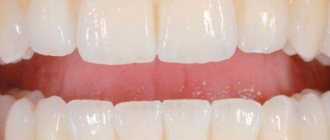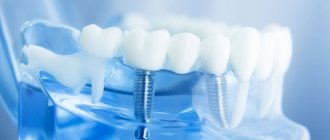In the lateral sections, teeth (molars, premolars) are subject to regular high loads, while their anatomical structure and location in the dentition makes care more difficult. Therefore, chewing units are destroyed faster due to various injuries and dental diseases. Prosthetics of molars and premolars involves the use of structures made of durable, reliable materials that are resistant to severe chewing loads. Dental crowns are orthopedic structures for single restorations, indicated when the upper part of the tooth is destroyed by more than 60%, when the installation of a filling is ineffective.
Types of dental crowns for chewing teeth
Molars and premolars are a kind of millstones that grind food before it enters the esophagus. They experience a high load, which can exceed 75 kg per 1 cm2. Therefore, chewing units are characterized by a massive size, a surface with many protruding tubercles. To restore molars and premolars, strong, reliable materials are used that can withstand increased loads. Orthopedic dentistry offers the following types of crowns for chewing teeth:
- Metal
– durable, corrosion-resistant, service life up to 10-12 years. The list of materials from which these structures are created includes: nickel-chromium alloy, cobalt-chromium alloy, titanium, alloys of noble metals (platinum, silver, gold, palladium). Solid metal alloy prostheses can be coated or not. These are the most inexpensive crowns, but the aesthetics leave much to be desired. Structures containing gold are characterized by high ductility and fit precisely to the tooth stump. The disadvantages of such dentures include excessive abrasion of the antagonist tooth (molar, premolar on the opposite jaw) with constant contact, poor aesthetics, and the development of allergies to the components of the metal alloy (beryllium, chromium, nickel). - Metal-ceramic
- reliable, durable dentures with a metal frame coated with a layer of ceramic mass. Metal-ceramic crowns are quite aesthetic, with an optimal ratio of reasonable price and good quality. Over time, the metal base begins to appear through the gums (gray stripe effect), which negatively affects the aesthetics. Therefore, it is not recommended to place such dentures on teeth along the smile line. - Crowns made of zirconium dioxide
are strong, durable structures that retain their original appearance throughout their service life (more than 15 years). The aesthetics are not inferior to ceramics and provide the tooth with a natural appearance. The biocompatible material is suitable for patients with metal allergies and is used for restoration of the frontal and chewing areas. The structures are manufactured using CAD/CAM technology, on a robotic machine, by milling. This eliminates any errors or inaccuracies, ensures precise fit of the structure to the tooth stump and gum, taking into account the type of jaw closure and the characteristics of the bite. - Metal-plastic
- inexpensive structures, which are a frame made of a metal alloy lined with plastic mass. Due to the porosity of the material, the surface of the prosthesis quickly darkens and absorbs dyes and odors from foods, drinks, and cigarettes. The metal alloy can provoke inflammation and allergies. Service life up to 3 years. Typically, such products are used for temporary prosthetics; they are unreliable as a permanent prosthetic structure.
Ceramic crowns are not suitable for the restoration of molars and premolars. Fragile ceramics are not able to withstand high chewing loads and quickly chip and crack. Ceramic crowns are placed on the front teeth, where the main criterion is high aesthetics. The incisors and canines are not subject to high loads, but participate in the formation of a smile and are visible during conversation. Ceramic restorations are identical to natural enamel in color and transparency and do not stand out from the dentition.
Dental formula
To understand how to count teeth, you can use a dental formula. It indicates the arrangement of elements in order, which is written using specialized notations. This is how the formula with the numbering of teeth is determined. The doctor examines the jaw and draws it up. The radical units are designated by Arabic values, and the temporal ones by Roman ones. The symbol looks like this:
I2/2C1/1P2/2M3/3=32.
In the expression, incisors are designated – I, premolars – P, molars – M.
In addition, dentists use tooth numbering. It is counted from the middle of the segment in the direction from left to right. Sometimes a number is added to the ordinal value to indicate the location zone. For example, the right canine on the top row is numbered thirteen.
Stages of installing a crown on a chewing tooth
- Diagnostics
– a comprehensive examination (orthopantomogram, 3D tomography), the dentist determines the general condition of the oral cavity, identifies dental problems, the presence of contraindications, draws up a treatment plan, and selects the optimal orthopedic design. - Preparation
- sanitization of the mouth (removal of plaque, tartar), treatment of teeth and gums (according to indications). The tooth is prepared for covering with a crown - the enamel is prepared, giving the stump the desired shape, the nerve is removed, the canals are filled, and, if necessary, the root is strengthened with a pin or inlay. To install zirconium structures, minimal tissue grinding is required; at the ILATAN clinic, a dental microscope is used for preparation, which allows you to remove enamel within a fraction of a millimeter. - Casts
- the doctor takes impressions of the patient’s jaws, from which a prosthesis is made in the laboratory. To protect the tissue, a temporary plastic crown is fixed to the prepared tooth. - Installation
- the finished crown is tried on, adjusted if necessary and fixed to the support with dental cement.
Which prosthetic option is optimal?
There is no type of prosthetics that is universal and ideal in all respects. Each technique has both advantages and disadvantages. Among the advantages of removable orthopedic devices are the following:
- the most simple, non-invasive installation, during which the patient does not experience any discomfort;
- financial accessibility – the cost of removable dentures can be called low;
- minimal number of contraindications - removable structures are suitable even for pregnant and lactating women.
However, there are also many shortcomings. The main one is the insufficient reliability of fixation of the structure. The denture must be removed from the mouth every day and cared for carefully. In this case, wear will be quite rapid.
Some removable structures have another problem - not the most aesthetic appearance. For example, if clasps are used for fastening, they will be noticeable to others.
Crowns and bridges are an affordable solution, which has two main advantages - high aesthetics and a relatively affordable cost. However, their installation requires turning, which significantly complicates the procedure and increases the list of contraindications.
Today, the most reliable option is implantation. Implants are the most functional solution. Teeth restored using implantation look aesthetically pleasing and last a long time. However, their installation is an invasive procedure in which the gums are prepared. However, this process goes smoothly and practically does not cause pain or discomfort in the patient. This is followed by a period of rehabilitation, when the patient needs to take medications and undergo regular dental examinations.
In our dental complex, the problem of missing chewing teeth will be solved individually. PRESIDENT specialists will select the method that best suits you!
The best crowns for chewing teeth
Since the main requirements for prosthetics of molars and premolars are the strength and durability of orthopedic systems, the best crowns for chewing teeth are made of zirconium or metal-ceramics. Zirconium is the most durable, lightweight material; installation of such structures requires minimal preparation of the abutment tooth, which is a big advantage over metal-ceramic products. The doctor will decide which restoration to use in a particular case after a detailed assessment of the clinical picture, the characteristics of the patient’s body, his wishes and financial capabilities.
How much do crowns cost in Moscow?
The cost of treatment depends on the complexity of the case, the volume of intervention, restoration material, and manufacturing technology. Installation of metal crowns in Moscow costs on average from 10,000 rubles. per unit, metal ceramics will cost from 15,000 rubles, and a zirconium dioxide crown – from 30,000 rubles.
The ILATAN clinic operates a case payment system, which protects the patient from unexpected expenses and hidden fees. The turnkey price includes all necessary measures for tooth restoration - from consultation to manufacturing and installation of a crown. Treatment of teeth, gums, production and installation of a core inlay, dismantling of old restorations are paid separately. The doctor will announce the exact amount of treatment during the consultation, after examination and diagnosis.
Universal system
It was developed in 1882 by Jesus Perreidt. To this day, this numbering method remains the simplest. Each tooth has its own specific number. The American Dental Association (ADA) approved this system in 1975. Since then, it has been a staple in US dental clinics.
Number 1 in the ADA system was given to the upper right molar. The remaining teeth are numbered clockwise from it. The lower right molar has the number 32. There are two designations for primary teeth - in Latin letters from A to T or numbers from 1 to 20 with the letter d.
Despite the apparent simplicity of the ADA system, it has a significant drawback. The number does not correlate with any anatomical features, so they need to be remembered. An advantage of the method is the convenience of notation on computer models.
Why implantation and not a bridge or removable denture?
- A dental bridge
is only suitable for included defects with a total length of no more than 4 teeth. The main disadvantage is that it requires grinding down two adjacent teeth for support. Sometimes these are completely healthy teeth that have to be covered with crowns. Service life 7-9 years. Does not prevent bone tissue atrophy. - A removable denture
is secured to crowns or natural teeth using special hooks. Most often, structures are made with support on an artificial palate, which makes them very uncomfortable to wear, can change diction, and provoke increased salivation and nausea. Fixation hooks put pressure on the tooth tissue, causing discomfort. Service life 3-5 years. Does not prevent bone tissue atrophy. - A bridge on implants
does not destroy other teeth, distributes the load evenly and is an excellent prevention of bone atrophy. It will cost more, but it will feel and look like your own teeth. It is not a source of discomfort, light and neat. Allows 100% restoration of the chewing function of the lateral parts of the jaw.
How does bone grafting proceed in the lateral parts of the jaw?
The sinus lift procedure on the upper jaw, according to our observations, is required in 80-90% of cases. In most cases, we use a protocol in which sinus lift is performed simultaneously with implantation. This allows you to reduce treatment time.
Sinus lift surgery can be closed or open. The closed type is more gentle and is easier to tolerate by the body.
When creating a bed for an implant, the mucous membrane of the maxillary sinus is lifted with a special tool and a limited amount of biomass is placed into the resulting cavity. Then implantation is performed. The implant takes root as the bone matures. The process takes 5-6 months.
Open sinus lift takes longer. A “window” is cut into the maxillary sinus from the side of the jaw, and then an osteoplastic mass is placed into the cavity, the hole is closed with a bioresorbable membrane and sutured with a gum flap. The engraftment period is 6-7 months.
In the lower jaw, bone grafting is performed using other methods. This is due to the predominant decrease not in the height of the bone, but in the width. To get rid of this deficiency, most often the bone is split and a non-load-bearing implant is implanted. The implantologist will be able to tell you after diagnosis which method of bone grafting is suitable in your case, and whether this procedure can be avoided and teeth implanted in one visit. Come for a consultation!
Our clinics
Clinic "Elident" on Varshavskaya
Varshavskoe highway, 75, bldg. 1, Moscow 117556
- Varshavskaya (500 m, closed until 2021)
- Nakhimovsky Prospekt (1,300 m)
Mon-Sat : 09:00-21:00; Sun : 09:00-19:00.
Online registration
+7 (495) 649-41-19
Elident Clinic in Annino
Varshavskoe highway, 154, building 1, Moscow 117405
- Annino (500 m)
- Academician Yangelya (700 m)
Mon-Sat : 09:00-21:00; Sun : 09:00-19:00.
Online registration
+7 (495) 649-41-19
What problems are encountered with maxillary implantation?
Replacement of lost premolars and molars in the upper jaw is always fraught with problems. Its lateral sections border the bottom of the maxillary sinus, and any loss of bone tissue in this place is fraught with problems with implantation. Yes, actually, not only with her. Any manipulation in this area can lead to complications - perforation of the maxillary sinus and the development of odontogenic sinusitis.
In some cases, the bone tissue is naturally thin, and the roots of the tooth may initially be located in the maxillary sinus. It is inconvenient to fill such a tooth, and after removal there remains a gaping hole connecting the oral cavity and the sinus. Naturally, in this case, immediate implantation is impossible, and the patient is indicated for bone grafting.
This operation in case of replacing long-missing teeth (over six months) is needed in 80-90 percent of cases. It complicates implantation and delays the achievement of results. Previously, the procedure was mandatory and added another 6-8 months to the total treatment period. Today, our clinic uses modern protocols that allow sinus lifting and implantation to be performed on the same day. You can find out more during your consultation.
